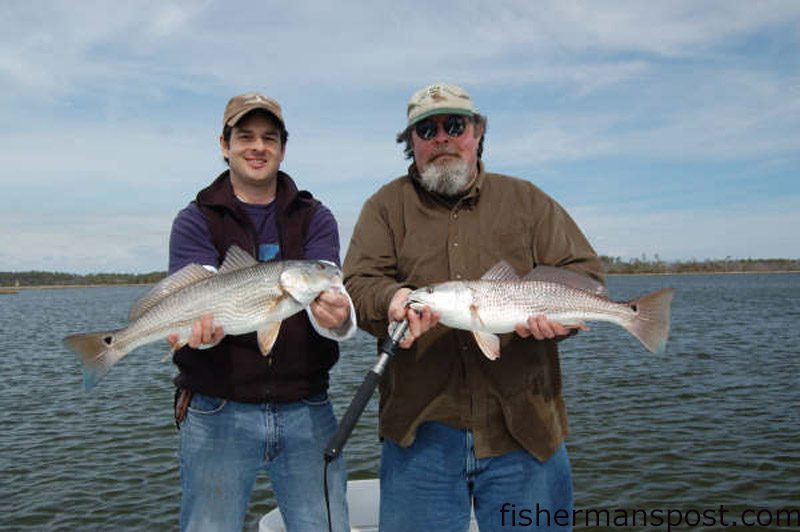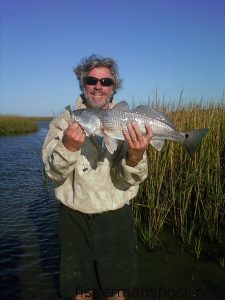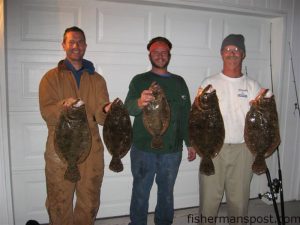Carolina Beach March 12, 2009
Dennis, of Island Tackle and Hardware, reports that there are some red drum feeding down in the bays behind Fort Fisher and in the local creeks. Soft plastics have been the most effective weapons against the reds lately, and Gulp baits, Trigger X soft baits, and Mirrolure’s new line of soft plastics have all been producing action.
Black drum with a few reds mixed in are holding beneath some of the docks off the ICW. It can take a while of fishing random docks to locate the fish, but once anglers find them, they’re schooled up in big numbers. Fresh shrimp on bottom rigs will get attention from the black drum.
Whiting have begun to move from the ocean, where they spent the winter, into the river mouth. Anglers can find them feeding along the bottom in deep holes and around structure. These early spring whiting are large ones, and a two hook bottom rig baited with shrimp will draw them to bite.
The trout bite has been a little slow since the cold weather at the beginning of the month, but it typically turns on in mid to late March. The boat basin and the river should produce some of the year’s first trout action. The grass islands of the Cape Fear usually host a good speck bite this time of year, and once anglers can catch or buy live shrimp, they should really be able to score on the trout. Mirrolures, Gulp baits, and soft plastic shrimp will produce bites for anglers who can’t find live shrimp.
The cold water has hurt the offshore bottom fishing lately, but spring’s warming water temperatures will offer anglers shots at sea bass and grouper at structure from 25 miles on out.
Not many boats have hit the Gulf Stream yet, but wahoo fishing should be excellent when the wind lays down enough for boats to make it offshore. It’s still a little early for the yellowfin tuna to show, but they’ll hopefully make an appearance at local bluewater hotspots later in the month. Trolling ballyhoo under skirted lures is the best way to target the Gulf Stream predators, and the wahoo seem to especially like red/black and purple/black color combinations.

Tank and Tom Nickerson, from Wilmington and Atlanta, with the results of a double hookup on red drum near Topsail. They were casting topwater plugs while fishing with Capt. Seth Vernon.
Brad, of Fish Spanker Charters, reports that while there are some bottom fish to be had offshore right now, working through the sharks to get to them has been a challenge lately. The bottom seems to be paved in sharks all the way out to the 40 mile range, and they’ll take an interest in virtually any bait anglers drop.
In between sharks, anglers have landed some red grouper and a few smaller gags along with other bottomfish at structure in the 30 mile range recently. Squid, cigar minnows, and cut baits will all produce action with the grouper and other bottom dwellers if the sharks leave them alone long enough.
As the water warms up and spring progresses, the shark problem should lessen, and anglers will see king mackerel follow the warm water closer to the beaches.
Nick, of Alford’s Seafood, reports that a few drum, speckled trout, and whiting have been coming out of the CB surf lately, with anglers reporting bites on mullet, squid, and shrimp.
Some fat whiting have been moving into the river mouth from offshore. A two hook bottom rig baited with shrimp and fished around the structure and deeper holes in the river will get their attention.
Bottom fishermen have been coming up with some big sea bass at wrecks, ledges, and other structure in the 25 mile range. The fish are falling for squid, cut baits, and jigging lures like Stingsilvers.
With the cool water temperatures, the best grouper bite has been well to the north. Boats have been reporting good catches of red grouper, but they’ve been about 40 miles offshore and north of Wrightsville.
Jeff, of Seahawk Charters, reports that red drum have been providing action for anglers all winter. The fish are feeding in the creeks and on flats in the lower Cape Fear River. On the flats, the fish are schooling up, and most are within the slot limit. The fish in the creeks are a little smaller and holding in small pods of a few fish each. In both areas, look for darker mud bottoms that warm the surrounding waters and concentrate the fish.
Scented soft baits like Gulp shrimp in New Penny, Molting, and Natural colors, as well as live mud minnows fished on jigheads, are producing most of the strikes on the reds.
As the water warms up over the next few weeks, the speckled trout bite should improve in the lower river as the fish move downriver from their winter haunts. The best places to begin looking for the early season trout are around creek mouths, rocky bottoms, and grass islands in the river between Snow’s Cut and Bald Head.
D.O.A. and Storm shrimp imitations are some of the best lures for the specks, fished either beneath a popping cork or crawled slowly along the bottom.


